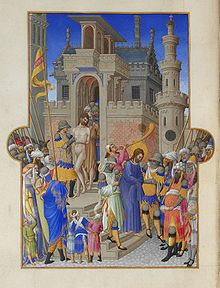Praetorium

with 34 hectares of floor space, it is likely one of the largest buildings in Germania inferior have been

A praetorium ( Greek πραιτώριον praitōrion , Germanized praetorium ) was originally the tent of the commander in a legionary camp in the Roman Republic . One can see here that the praetor originally held the supreme command. If a marching camp was set up, the first thing to do was to find a place for the praetorium ( Polybios 6:27), which occupied the central position of a camp. The tent was flanked by an open market and the quaestor's tent . The street and gate closest to the tent were called via praetoria and porta praetoria .
The word praetorium also referred to the advice of the officers in the praetorium. Later the designation was generally transferred to the seat of a commander-in-chief or the governor of a province (from there also to court buildings).
In the permanent legion camps of the imperial era, the praetorium was the living quarters of the legionary commander, while the staff was housed in the adjoining principia . The principia were now the center of the camp. A praetorium as the seat of the governor has been preserved in Cologne , for example .
The quarters on the highways that were reserved for officials traveling on official missions were also referred to as the praetorium ( CIL III, 6123 ).
In general terms, especially with poets, but also with ancient historians ( Suetonius ), every large, palatial building (e.g. on an estate) could be referred to as a praetorium , even if the term was mostly limited to the buildings in which there was actually a Emperor or King lived. The imperial bodyguard, the Praetorian Guard was following the Praetorium of the Princeps in Rome Praetorium called.
The Praitorion in Constantinople became historically significant . It was the official seat of the Stadteparchen and at the same time a state prison for opposition members, such as B. Iconoclasts ( Stephanos the Younger ) and candidates for the throne, some of whom were freed in revolts, others were blinded and killed, or Arab prisoners of war. In the 8th century, the first mosque in Constantinople is said to have been built in or at least near the praitorion for the Arab prisoners of war .
Praetorium in the Bible
A praetorium is also mentioned in the Bible: In the Gospel of Mark (15.16 EU ) and the Gospel of John (18.28 EU ; 19.9 EU ) the two evangelists report that Jesus Christ before his condemnation to Pontius Pilate , the prefect of Judea , who was in his Praetorium. When he proposed to the Jews who had gathered in front of his praetorium that Jesus be released (it was the custom for the governor to release a prisoner on Passover ), they loudly demanded the release of Barabbas and the crucifixion of Jesus.
In Acts 23:35 EU , the governor Marcus Antonius Felix has the apostle Paul guarded in Herod's Praetorium.
The term is mentioned again in Phil 1,13 EU . Here Paul tells of his fetters for Christ's sake, which have been revealed in the Praetorium and among all others.
literature
- Carl Mommert : The Praetorium of Pilate or the place of the condemnation of Jesus. E. Haberland, Leipzig 1903 ( online ).
- Rudolf Schultze : The Praetorium of Vetera and its architectural remains. Georgi, Bonn 1921.
- Herbert Lorenz : investigation into the Praetorium. Catalog of the pretories and development history of their types. Dissertation, Halle / Saale 1936.
- Rudolf Egger : The Praetorium as the official seat and quarters of top Roman officials (= meeting reports of the Austrian Academy of Sciences, Philosophical-Historical Class. Volume 250, Abh. 4). Austrian Academy of Sciences / Böhlau, Graz, Vienna, Cologne 1966.
- Gundolf Precht : Building history study of the Roman Praetorium in Cologne (= Rhenish excavations. Volume 14). Rheinland-Verlag / Habelt, Cologne / Bonn 1973, ISBN 3-7927-0181-2 .
- Christine Meyer-Freuler: The Praetorium and the Basilica of Vindonissa. The excavations in the southeastern part of the legionary camp (excavations Scheuerhof 1967/68, Walleg 1979 and Koprio 1980) (= publications of the Society for Vindonissa. Volume 9). Pro Vindonissa Society, Brugg 1989.
- Peter Scherrer : grave building - residential building - tower castle - praetorium. Allegedly Roman-era sacred buildings and alleged pagan-Christian cult continuities in Noricum (= Austrian Archaeological Institute: Reports and Materials. Issue 4). Austrian Archaeological Institute, Vienna 1992, ISBN 3-900305-12-9 .
- Bernard Andreae : Praetorium speluncae. Tiberius and Ovid in Sperlonga (= Academy of Sciences and Literature: Treatises of the humanities and social sciences class. 1994, No. 12). Steiner, Stuttgart 1994, ISBN 3-515-06643-8 .
- Felix F. Schäfer: The praetorium in Cologne and other governor palaces in the Roman Empire. An architectural historical study and a comparative study of type and function . Dissertation, University of Cologne 2004 ( online ).

